Fishing
Fishing in Alaska fulfills the dreams of many anglers, offering a remarkable experience. At Crystal Creek Lodge, our guests relish the opportunity to catch a wide array of fish species. Throughout the season, we boast abundant rainbow trout, dolly varden, char, and grayling. Additionally, various salmon species are available. King salmon are pursued from the second week of June to the end of July, and silver salmon are targeted from late July through the middle of September.

The stunning natural beauty and wildness of Alaska is your backdrop for a fishing vacation with Crystal Creek Lodge. We are by intention a couples and family-friendly vacation destination.
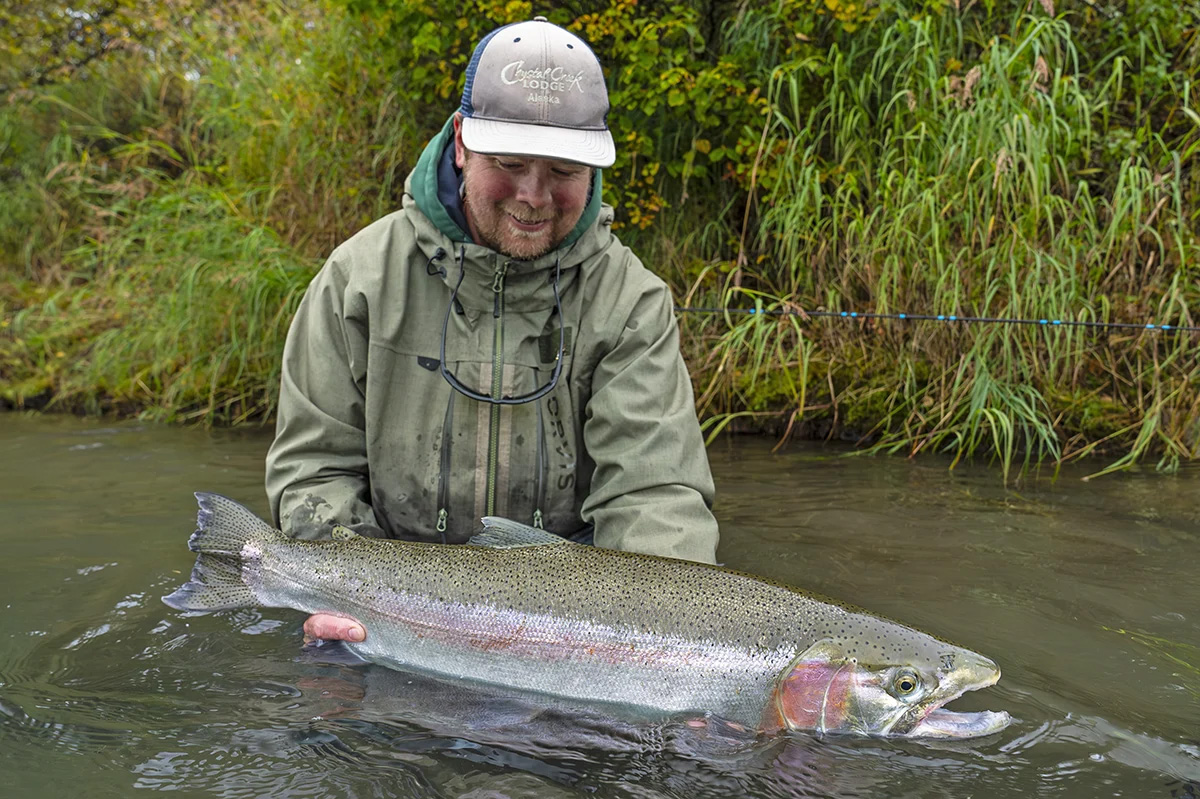
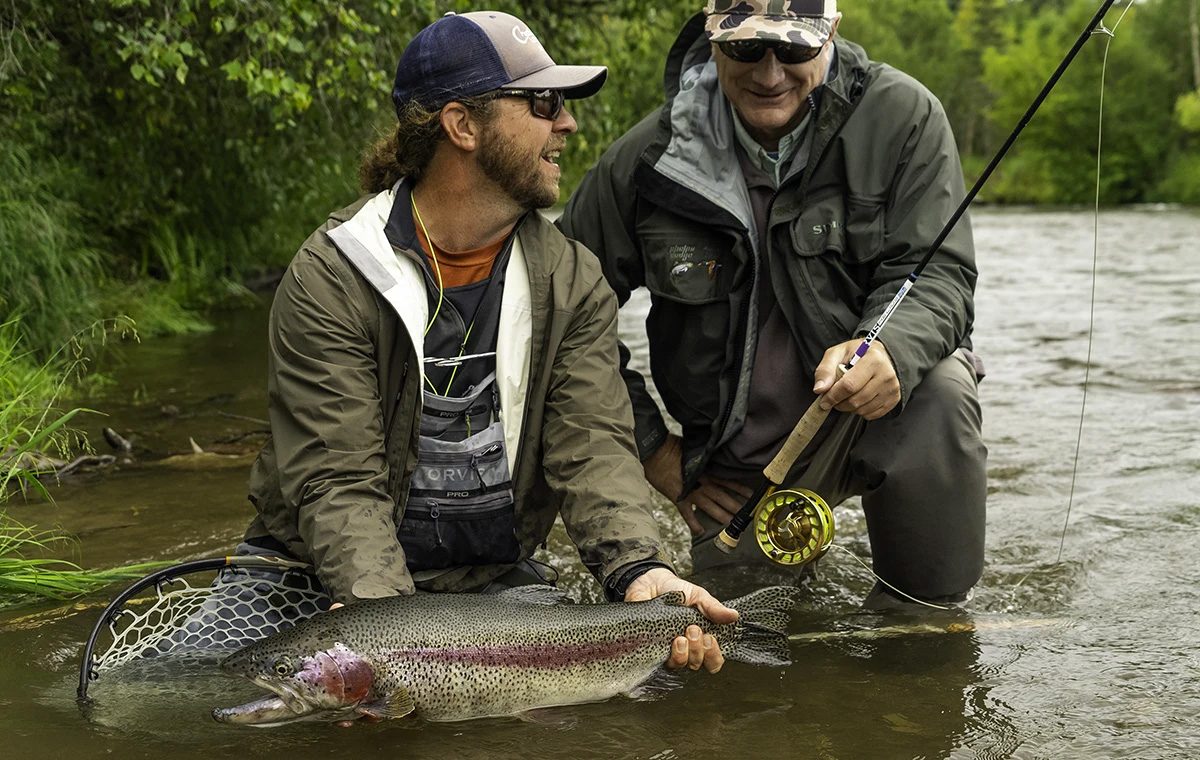
Rainbow Trout
The rainbow trout of Alaska are legendary. The Naknek River and streams of the surrounding Katmai National Park region offer some of the finest Alaska rainbow trout fishing in the world. Crystal Creek Lodge sits on the Naknek River and lies very close to other famous rivers and streams of Katmai. Consequently, many of Crystal Creek Lodge’s guests love to pursue rainbow trout, often engaging in walk-wade fly-fishing. Most rivers and streams that are fished have clear-flowing, gravel-bottomed waters, making them easily wadeable.
More on Alaska Rainbow Trout 🎥
For many anglers, fishing for Alaskan Rainbow Trout is a once in a lifetime experience. For me, this has become a 20 year obsession. The variety of habitat, size and beauty of the fish, and the overall experience of the Alaskan wilderness is exhilarating. From set to release, it is pure joy.
Dave M. Anqwin, CA
Alaska rainbow trout are wild, beautiful fish, adorned with spots, color, and character. Fish exceeding 20 inches are abundant in the region, and you can expect a fish over 30 inches to inspect your fly during your visit. These fish make their living on the move, exhibiting highly migratory behavior as they traverse river systems and exploit available food sources. Life on the move shapes them into strong fish that leap with abandon and challenge anglers by tearing line from reels. Holding onto big ones can be quite challenging!
Alaska rainbow trout predominantly rely on salmon-based food sources, mimicked by the flies anglers employ. Anglers favor these wet flies, which mimic salmon eggs, fry, and flesh. In the brief summer, the seasonal arrival of spawning salmon floods these waters with protein, eagerly devoured by the trout. Despite the allure of dry fly activity, Alaska’s rainbow trout often prioritize feeding on salmon eggs, given their high protein yield compared to insects. Alaska earns renown for its hefty Rainbow Trout, contrasting with the thriving dry fly fishing scene in the western Rocky Mountain States. Though occasional exceptional days of dry fly fishing occur before the salmon spawn, guests should expect to predominantly use wet flies throughout their trip.
The Naknek River, which serves as the lodge’s home water, holds wild rainbow trout exceeding 30 inches in length, a rarity among rivers worldwide. While certain weeks may offer better opportunities than others, the chance to catch these sizable Naknek fish persists throughout the season. Big fish require substantial sustenance, and the Naknek River furnishes a corridor of protein-rich food sources, including salmon fry, salmon smolt, smelt, sculpins, and lampreys. Fishing the Naknek is most effective when employing sinking lines and large, articulated leech patterns to lure the fish. The rapids considered the prime section of the Naknek, are just a short boat ride away. Occasionally, the fishing at the rapids is so exceptional that guests request to camp there, though with such a comfortable lodge nearby, why bother with camping?
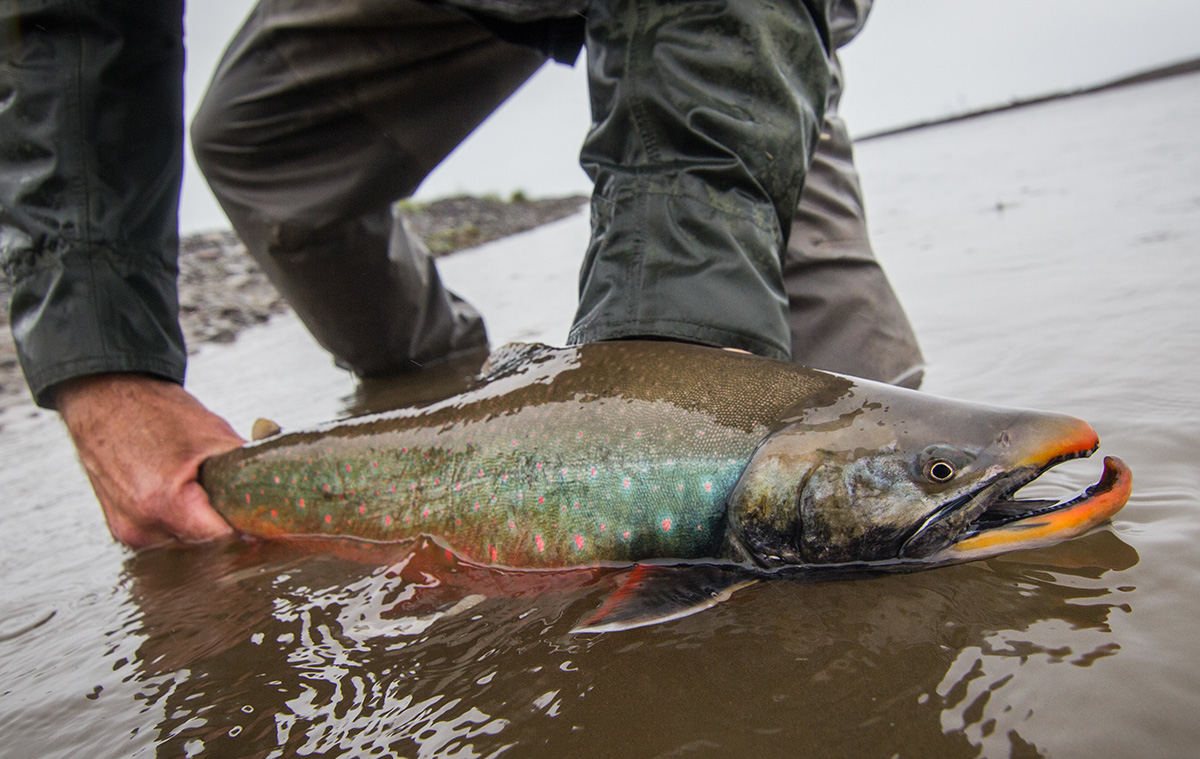
Char Fishing
Artic char and dolly varden in Alaska are renowned for their hard-fighting nature, providing anglers with thrilling battles against these strong and resilient fish. The chars are common to Arctic and subarctic waters, and thrive in the Bristol Bay region. They are aggressive, strong and beautiful fish that populate streams in prolific numbers. It is common for anglers to catch dozens of char in the 18-28+ inch range.
More on Char Fishing and our Catch-and-Release video 🎥
The chars, widely represented throughout the Bristol Bay region, have become beloved quarries for Crystal Creek anglers. Dolly varden char and Arctic char populate the sub-arctic waters accessible from the lodge, and CCL anglers regularly encounter them in remarkable numbers. Some of our preferred streams offer 100 fish days, and anglers can reel in dozens of char ranging from 18 to 28 inches during a single day of fishing. However, char offers our guests more than just a high-volume angling opportunity; they symbolize the far north and are a defining element of the Alaska fishing experience.
By nature, chars are aggressive, strong, and colorful fish that gather in the region’s smaller streams. Similar to their cousin, the brook trout, Arctic char, and dolly varden eagerly take the bait and put up a strong fight, but it’s their physical appearance that truly distinguishes them. Chars display a deep olive color that fades to silver along the flanks. They have distinctive whitish, yellow, or orange/brown spots that become more pronounced towards the belly, and the leading edge of their fin margins is stark white. The overall coloration of chars varies based on predominant feed and the time of year, although dolly varden tend to be lighter and more silvered than Arctic char. As the northern autumn approaches, both species acquire remarkable spawning colors, becoming the most stunning of Alaska’s game fish. Throughout the season, chars are truly a sight to behold.
At Crystal Creek Lodge, guests craft unforgettable memories, especially during a day or more of char fishing, which adds vibrant hues to those cherished experiences! Take advantage of CCL’s unique access to these remarkable fish, and the untrammeled places in which they live.
Watch our Catch-and-Release Video
When Crystal Creek Lodge began in 1988, we embraced “Catch-and-Release” as a policy for native fish (rainbow trout, the char species and grayling) when it was a relatively new idea. Despite substantial, initial resistance it has proven over time to be an exceptional and successful conservation practice to promote fish survival and healthy fisheries.

King Salmon Fishing
Catching a King Salmon in Alaska is an electrifying experience, as anglers feel the raw power and adrenaline rush of battling one of the most prized and majestic fish in the world’s renowned salmon rivers. Prime king season is June 15 through July 30. Kings are the largest of the Pacific salmons. They average 15-30 pounds, though each year a handful of brawlers tip the scales in the vicinity of 50 pounds. In season, we literally can catch kings within sight of our dock. The second half of July is the best time to fish Kings on the Naknek River.
More on King Salmon Fishing
Among the diverse species that characterize the Alaskan fishery, the chinook salmon, also known as king salmon in Alaska, stands out as the crown jewel. These majestic fish, returning each year to the heart of their spawning grounds in the Bristol Bay region, cruise the deep channels of the Naknek and Nushagak Rivers as a hidden ransom of silver. The king salmon run on the Nushagak, a major river only 35 miles west of Crystal Creek Lodge, is host to the largest wild king salmon run remaining in the world, with an annual average of 100,000 fish in that river alone.
Prime king season is June 15 through July 30. Kings are the largest of the Pacific salmons. They average 15-30 pounds, though each year a handful of brawlers tip the scales in the vicinity of 50 pounds. Kings generally depart the freshwater rivers at two years of age. They then spend one to five years in the hardscrabble waters of the Pacific before returning to their natal rivers to spawn. They range thousands of miles at sea as they feed, converting plankton, seaweeds, jellyfish, starfish, and crustaceans into firm (and delicious) pink flesh. As they re-enter the freshwater system, kings navigate the deepest channels in their journey upstream, often traveling solo or in scattered small groups. The king salmon is a miracle of strength and raw power. The specimens in CCL’s frequented rivers are gunmetal grey fading to silver-purple, slab-sided, angry-eyed, and line-ripping strong. Tail margins feature supporting cartilage that adds to the surging power of these fish, and in the fight, that power will test the angler.

Fly tackle can be employed for kings and due to their preference for deep river holes most of our guests use casting or spinning tackle. we encourage fishing from a boat to cover the maximum amount of suitable water. Trolling or casting is the general rule; the solitary nature of kings requires an aggressive and expansive approach, and though tidal areas tend to see the greatest incidence of hookups, CCL guides go the distance to find fish throughout the river systems. That said, some of the finest king salmon fishing in the world is within sight of Crystal Creek Lodge. Many large Naknek kings have become the cornerstone of a CCL guest’s memorable experiences.
King salmon fishing at Crystal Creek Lodge is quite literally the stuff of legend. To feel the massive pull of something so fundamentally wild is a rare gift, and one not easily forgotten. The king’s strength, aggression, and wild essence are epochal of the Alaskan angling experience. They are called king salmon for good reason.
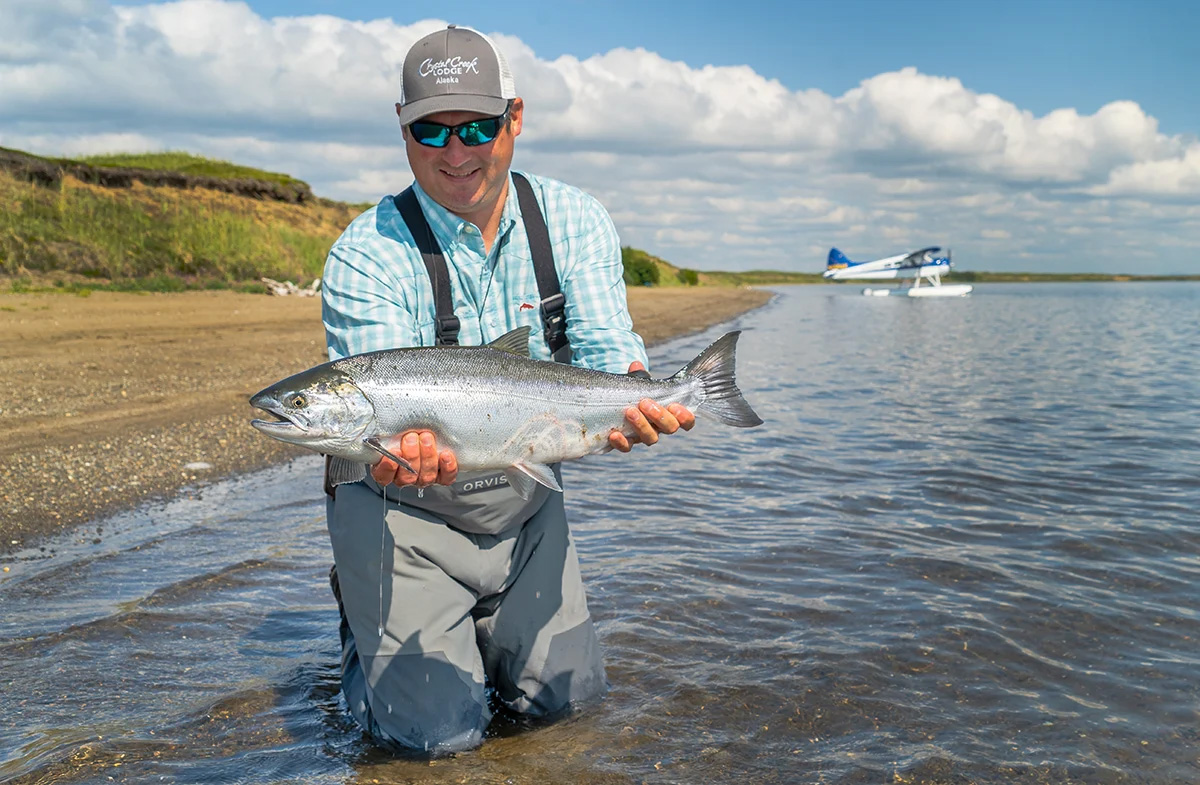
Salmon Fishing
In the heart of Alaska’s untamed wilderness, there’s nothing quite like the thrill of hooking into a wild salmon, feeling the raw power of nature coursing through every exhilarating moment of the fight. Five species of Pacific salmon run the local rivers by the millions and they are thus available in prolific numbers. One or two species of salmon are available in peak configuration during any week of the season… Alaska salmon fishing at it’s best! Our home River, the Naknek, sees a sockeye salmon run into the millions of fish.
More on Alaska Salmon Fishing
Five Species of Pacific salmon run the local rivers by the millions and they are thus available in prolific numbers. One or two species of salmon are available in peak configuration during most weeks of the season. Some weeks in July offer four or all five species of salmon to be caught. A reasonable expectation for salmon availability can be made as follows:
- Mid-to-late June: King and chum salmon. Catch, keep, and taking fish home is possible.
- Late June to mid-July: king, chum, and sockeye salmon. Catch, keep, and taking fish home is possible.
- Mid-to-late July: king, chum, and pink salmon. Catch, keep, and taking fish home is possible.
- August: silver salmon and pink salmon. Catch, keep, and taking fish home is possible.
- September: silver salmon are abundant this month and taking fish home is possible.
These five salmon are available on fishing trips throughout the season Chum, sockeye, pink, and silver salmon are caught by spin or fly fishing on the Naknek River or while wading one of several rivers within 75 miles flying radius of the lodge. Some of Alaska’s finest wild salmon rivers are within easy reach of the lodge and we have developed an exceptional guided salmon fishing program to help you catch them.
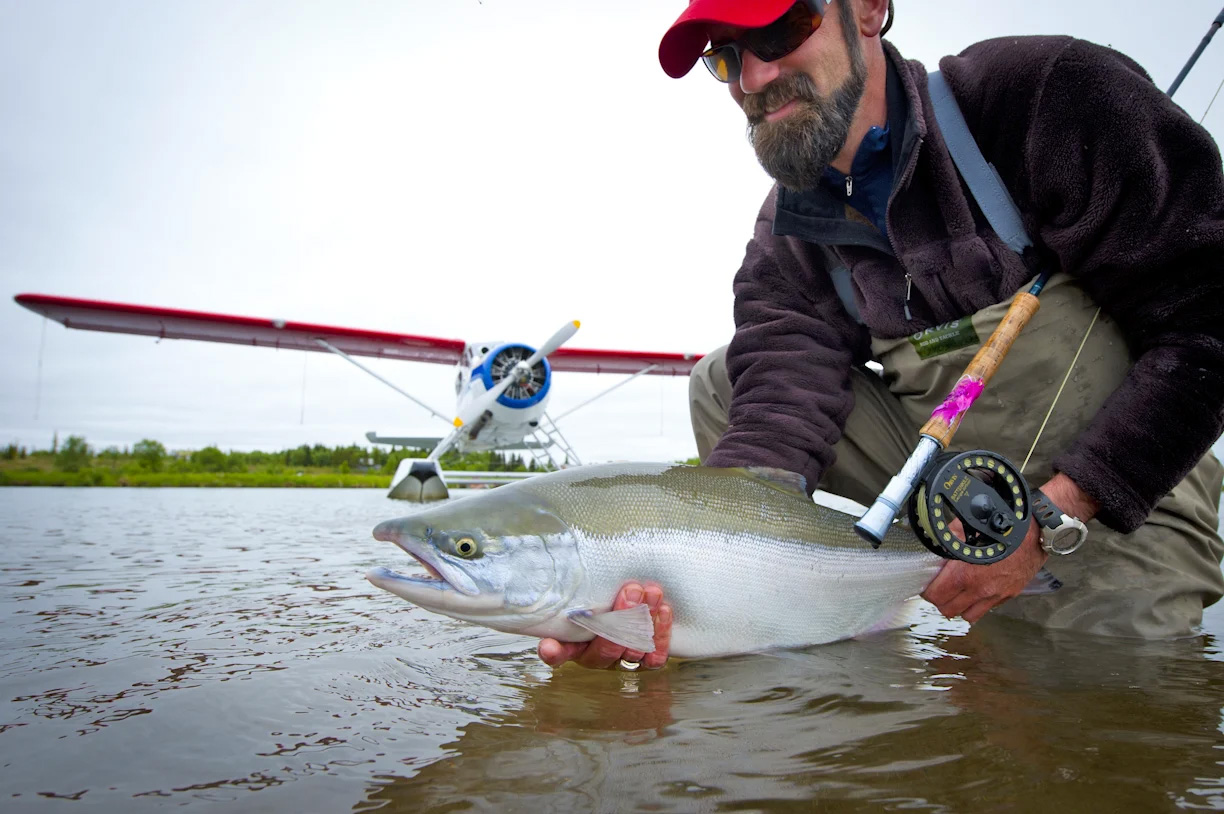
Sockeye Salmon average 6-8 pounds with larger fish to 11-plus pounds. They are the most numerous of the salmon, with numbers in some rivers running in the millions. Sockeye salmon are best caught on a fly and pound-for-found is the hardest fighting of the salmon. Their firm, red meat is the finest for eating. We fish for sockeye from late June through late July and they are available at several different rivers. Some of the best fishing is had on the Naknek River. The best season for sockeye salmon fishing: late June through mid-July.

King Salmon are the largest of the Pacific Salmon, averaging 15-30 pounds, with larger fish up to 50-plus pounds. Kings are fished most effectively with spinning or casting tackle, fishing either the Nushagak or Naknek Rivers. The Nushagak is only 35 miles west of the lodge. and it’s run of kings is the largest wild king run in the world, with an annual average of 100,000 fish in that river alone. The best season for king salmon fishing: Mid-June to Late July.
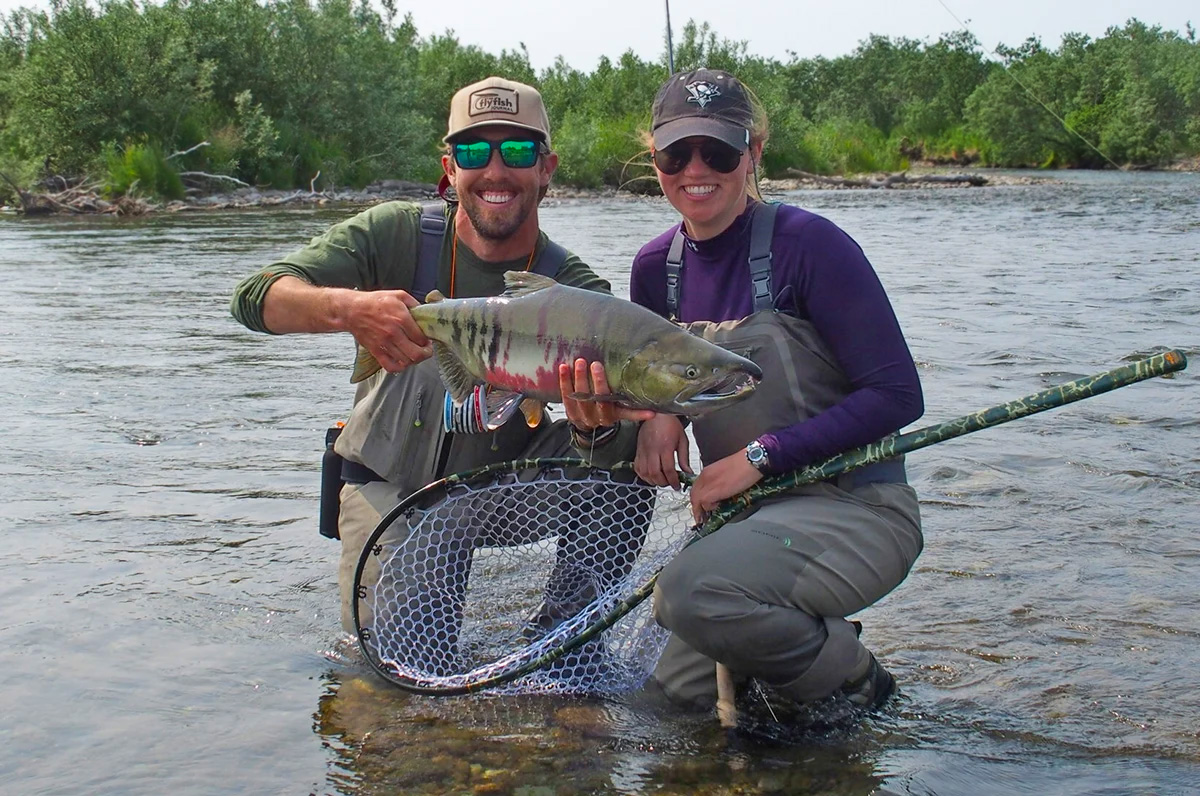
Chum Salmon average 7-9 pounds, with larger fish to 15-plus pounds. Chums are taken on spinning or casting tackle. These hard-fighting fish migrate and hold in large groups. Chum salmon are easily caught while wading in shallow water. This can make for very fast action on medium-weight fishing tackle. Chums are an extremely underrated sport fish. They fight pound for pound like a silver salmon and take the fly voraciously. The Alaska Peninsula and some of the best small stream coastal chum salmon fishing in the world. The best season for chum salmon fishing: late June through late August.
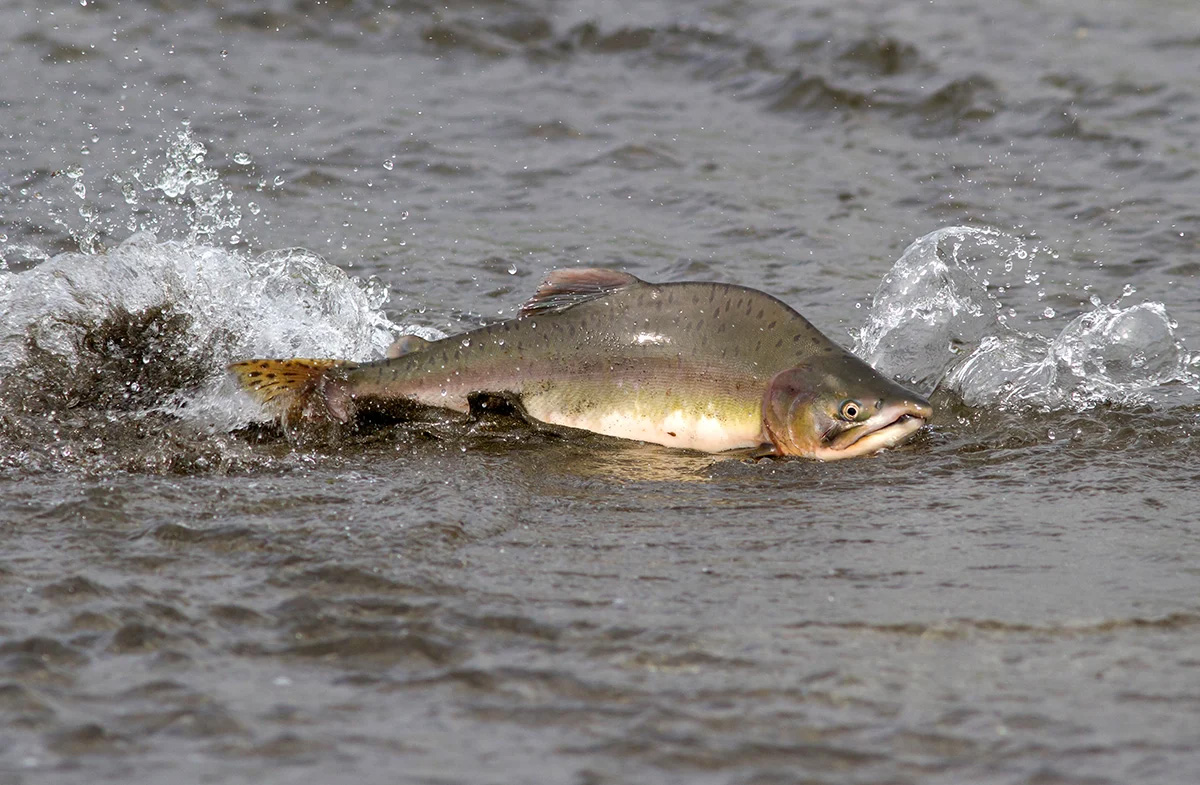
Pink Salmon average 3-5 pounds with larger fish to 6-plus pounds. Due to a two-year life cycle, their most prolific runs occur on even-numbered years. Pink salmon or humpy as they are sometimes called, are aggressive strikers that can be caught on light spinning or fly fishing tackle in large numbers. It’s not unusual to catch 50-100 five-pound fish for a day’s effort. The best season for pink salmon fishing: late July through late August.
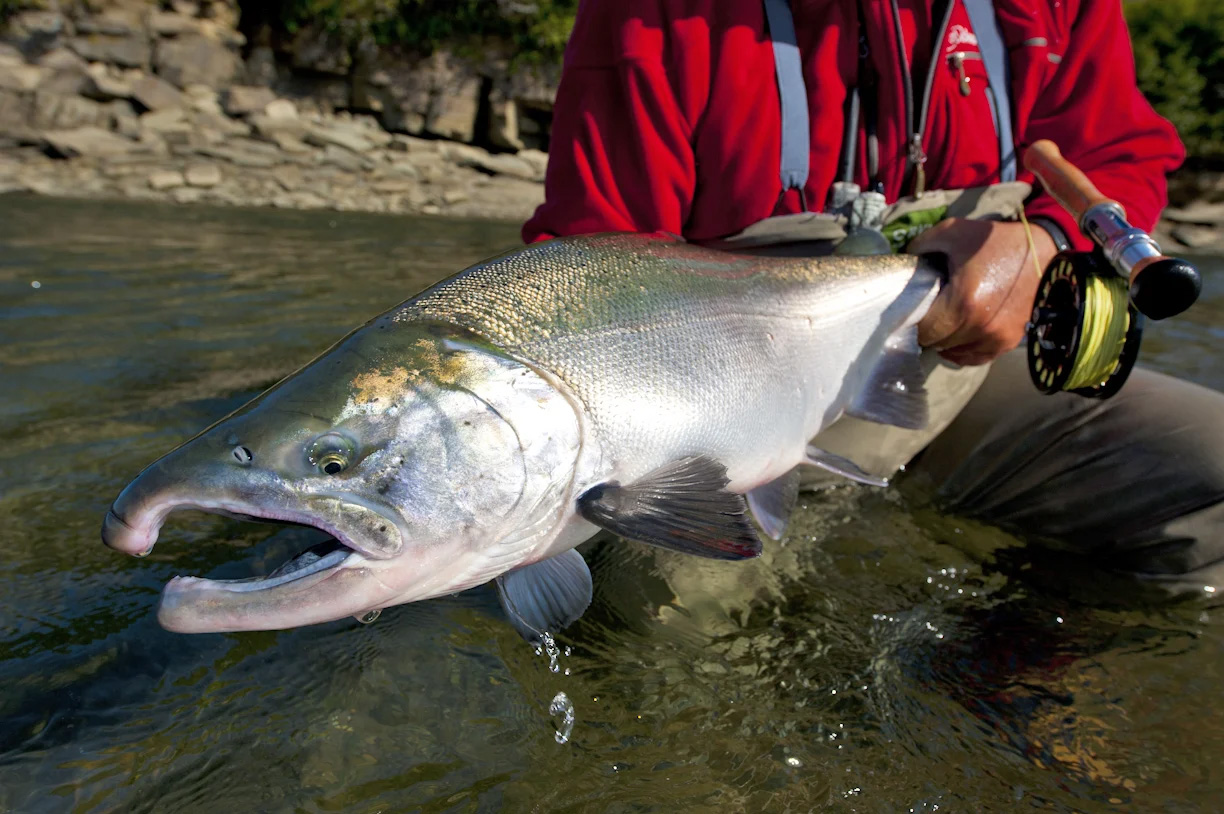
Silver Salmon average 7-9 pounds with larger fish to 15-plus pounds. Fishing for silvers in Alaska is pure excitement. Once you’ve set the hook, hold on and get ready for a wild ride. They run in shallow water, hold in large groups and readily take the proper fly or lure. Silver salmon run strong and leap high in the air when hooked. The best season for silver salmon fishing: late July through late September.
Keeping salmon and taking them home
Those who wish to keep salmon are encouraged to do so within the daily and total possession limits set by the State of Alaska.
While not mandatory we do encourage catch-and-release of female salmon for conservation reasons and the fact that the male salmon have better quality meat and a higher yield of meat per pound. Your guide will assist with the identification and the harvest of the best quality salmon.
We will carefully clean, vacuum package, and freeze guest salmon for shipment home. Additionally, we provide an airline-approved seafood shipping container for transporting fish as checked baggage.
To prevent spoilage, we refrain from shipping salmon on behalf of guests. If guests wish to have their salmon smoked, we will assist in arranging and shipping their salmon to a reputable processing facility in Anchorage. Please reach out for more information.
Commercially caught and professionally processed sockeye salmon fillets are available to any guest at any time of the season in virtually any quantity desired at local wholesale prices if ordered in advance. Please inquire for details.
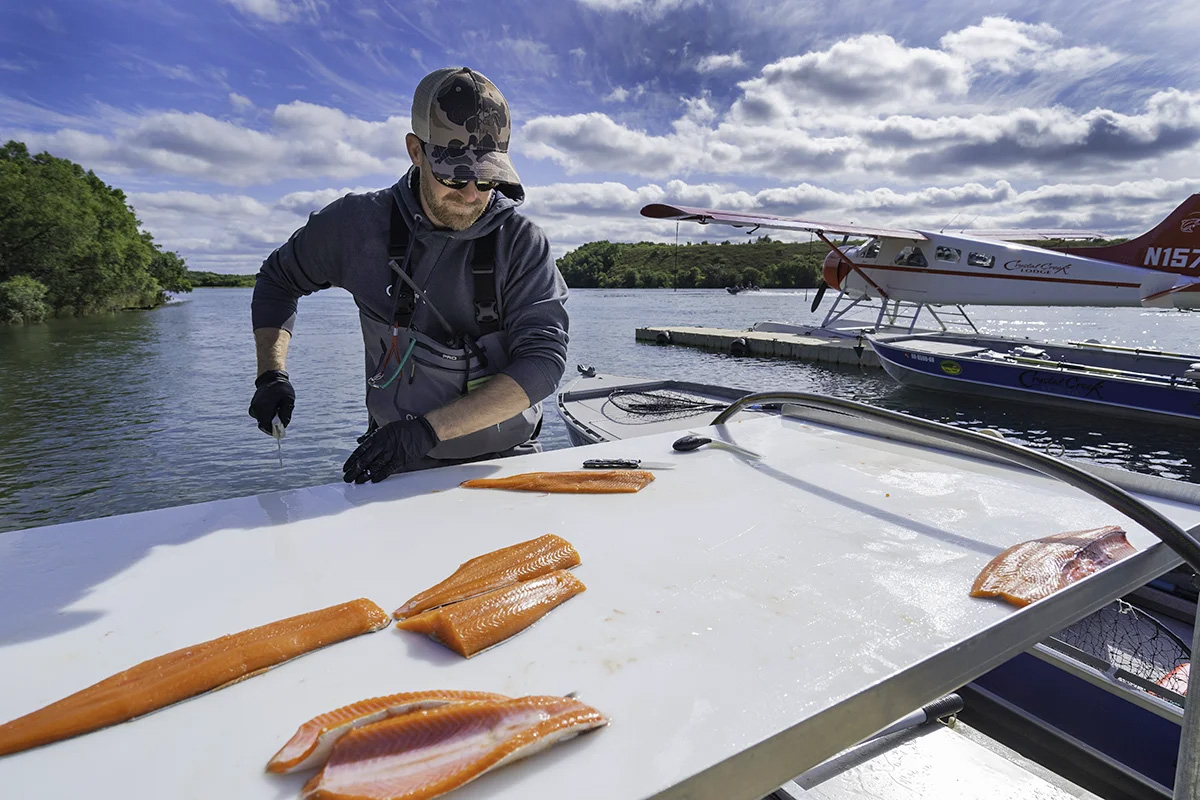

American Creek
American Creek Concession, Katmai National Park
The American Creek is a world-famous, prolific rainbow trout, dolly varden, and grayling fishery in Katmai National Park. It is deep in the Naknek River watershed. To reach its remote location one must fly to the American in a floatplane or boat scores of miles and several lakes and rivers from King Salmon. We choose the floatplane method. The American Creek destination is a concession within Katmai held by special permit. By regulation specific to this stream, all of these treasured fish must be release by your guide and must never leave the water. You’ll see for yourself why this is such a special place.
More about American Creek
The American Creek is a fly fishing only, catch and release destination. Many fishing possibilities can present themselves from early-season mousing or dry fly fishing to FAT late-season rainbow trout. While there you may be lucky enough to fish with the brown bears of Katmai, as it is a place where the bears fish for the prolific sockeye salmon that spawn there.
American Creek is located at the approximate center of the Katmai region, flowing between Hamersley Lake and Coville Lake. The lower section of the American Creek is woody and braided, and a long walk from effective seaplane landing areas. One must have a boat to fish it effectively. The National Park Service issues six concessions to fish the American Creek by boat, and Crystal Creek Lodge holds one of the concessions.
There is no extra charge to fish the American Creek. Please inquire as to current conditions and availability while meeting with your guides at the lodge.
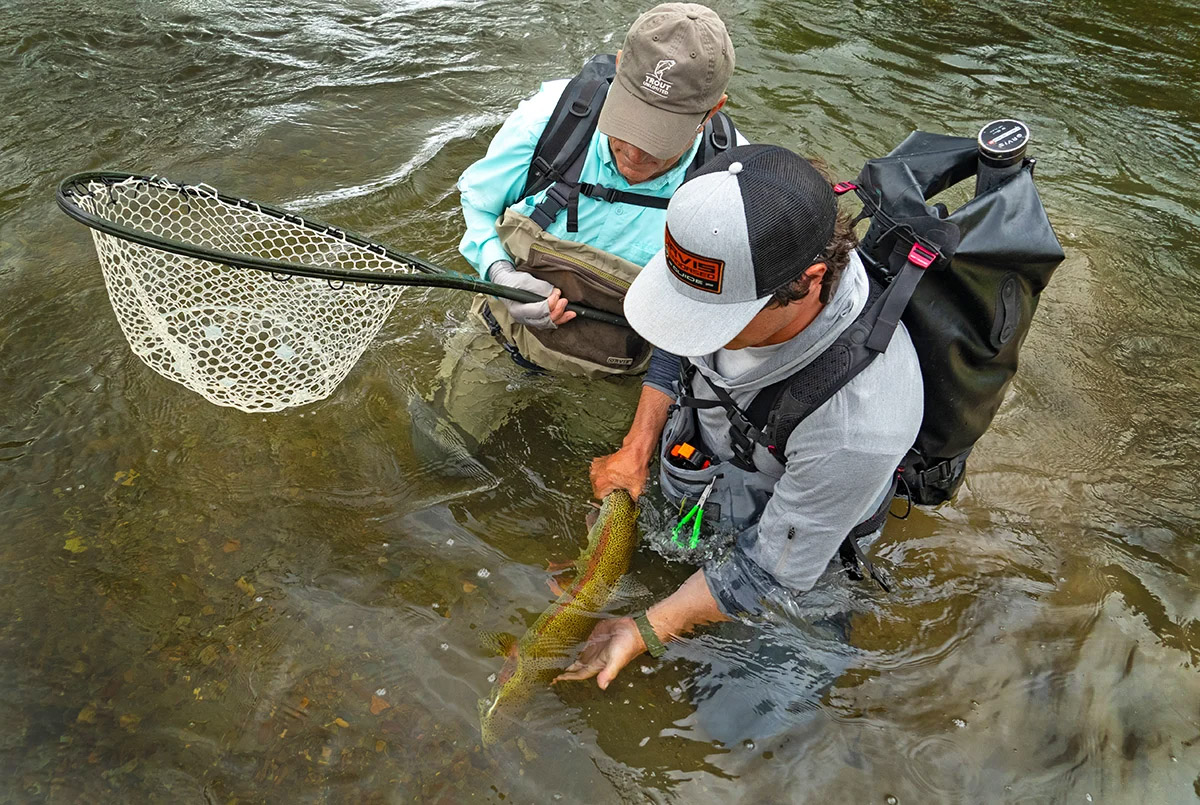
During the short, 20-minute flight from Crystal Creek Lodge to American Creek, you’ll enjoy breathtaking views of Naknek Lake, Grosvener Lake, Coville Lake, and possibly several dormant volcanoes, as well as the famous Valley of 10,000 Smokes. Along the way, you’ll also have the opportunity to observe and learn about notable historic sites from both ancient and modern eras.
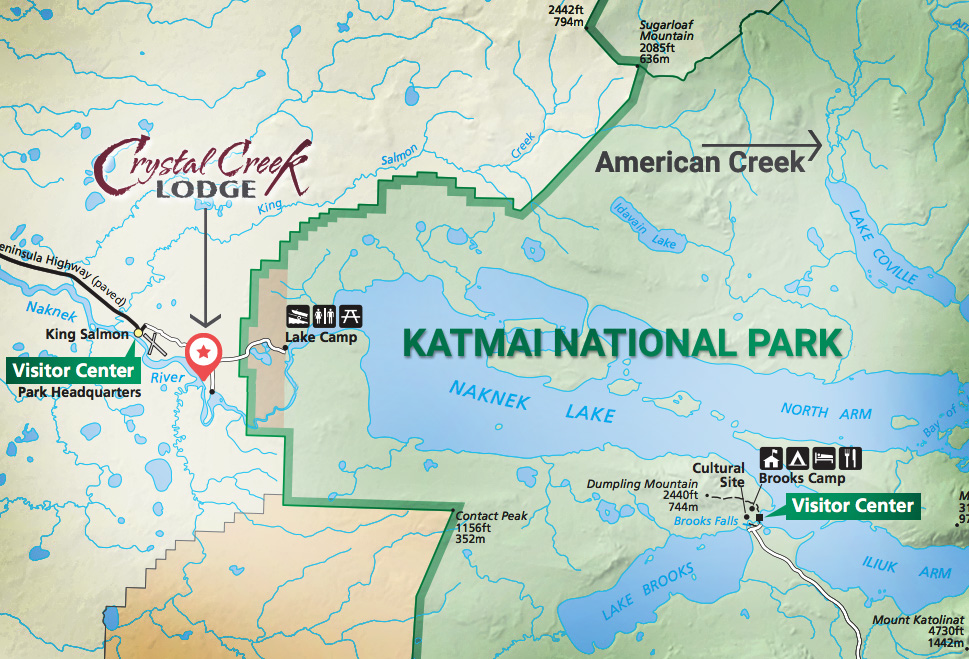
Please view our Catch-and-Release video. You will be given the opportunity to review this video at the lodge during check-in.
Crystal Creek Lodge’s map official map of Fishing & Adventure

Fly-out fishing in the Alaska Peninsula region offers anglers the opportunity to access remote and pristine waters teeming with trophy-sized fish, including salmon, trout, char, and more. With breathtaking scenery and abundant wildlife, each fly-out excursion promises an unforgettable adventure in one of the world’s last great wilderness areas.
Crushing expectations!
From the moment we arrived until our departure Crystal Creek Lodge exceeded our expectations in every way! Equipment, facilities, service, FISHING! The staff made the trip with their friendly “can do” attitude! We can’t wait to return!